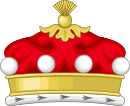| Barony of Birdwood | |
|---|---|
  Azure, five martlets, two, two and one, within an inescutcheon voided a representation of the Southern Cross, all argent | |
| Creation date | 25 January 1938 [1] |
| Created by | King George VI |
| Peerage | Peerage of the United Kingdom |
| First holder | Sir William Birdwood, 1st Baronet |
| Last holder | Mark Birdwood, 3rd Baron Birdwood |
| Remainder to | 1st Baron's heirs male of the body lawfully begotten |
| Subsidiary titles | Baronet, of Anzac and Totnes |
| Extinction date | 11 July 2015 [2] |
| Motto | In bello quies ("Cool in action") [1] |
Baron Birdwood, of Anzac and of Totnes in the County of Devon, was a title in the Peerage of the United Kingdom. It was created on 25 January 1938 for Sir William Birdwood, 1st Baronet. [3] He is chiefly remembered as the commander of the Australian and New Zealand Army Corps (ANZAC) during the Gallipoli Campaign of 1915. Birdwood had already been created a Baronet, of Anzac and Totnes, on 29 December 1919. [4]
Contents
The first two barons had only one son each. Upon the death of the 3rd Baron without male issue in 2015, the barony and baronetcy became extinct. [2]
The right-wing political activist Jane Birdwood, Baroness Birdwood, was the second wife of the second Baron.
